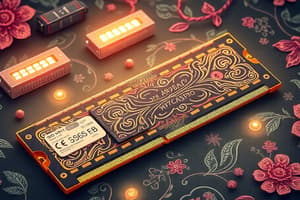Podcast
Questions and Answers
What is the primary function of primary memory in a computer?
What is the primary function of primary memory in a computer?
- To temporarily store data and instructions for the CPU (correct)
- To connect different devices within the computer
- To permanently store data and programs
- To provide backup power for the system
Which type of memory is characterized as non-volatile?
Which type of memory is characterized as non-volatile?
- SRAM (Static Random Access Memory)
- RAM (Random Access Memory)
- EEPROM (Electrically Erasable Programmable Read Only Memory) (correct)
- DRAM (Dynamic Random Access Memory)
What distinguishes EPROM from PROM?
What distinguishes EPROM from PROM?
- EPROM uses magnetic fields to store data
- EPROM can be erased and reprogrammed using electrical current (correct)
- PROM can store data that is erasable once written
- PROM allows data to be changed multiple times
Which type of RAM is considered non-volatile?
Which type of RAM is considered non-volatile?
For how many times can data be programmed and erased in EEPROM?
For how many times can data be programmed and erased in EEPROM?
What happens to data stored in RAM when the power is turned off?
What happens to data stored in RAM when the power is turned off?
What is a key characteristic of cache memory?
What is a key characteristic of cache memory?
Which of the following is NOT a characteristic of ROM?
Which of the following is NOT a characteristic of ROM?
What is a key characteristic of SRAM compared to DRAM?
What is a key characteristic of SRAM compared to DRAM?
What distinguishes SDRAM from traditional DRAM?
What distinguishes SDRAM from traditional DRAM?
Which of the following statements about DRAM is correct?
Which of the following statements about DRAM is correct?
What is the primary purpose of cache memory?
What is the primary purpose of cache memory?
Which of the following correctly describes SSDs?
Which of the following correctly describes SSDs?
Flashcards
Primary Memory
Primary Memory
Stores data directly accessible by the CPU.
SRAM (Static RAM)
SRAM (Static RAM)
A type of primary memory that holds data as long as the power is on; faster than DRAM.
DRAM (Dynamic RAM)
DRAM (Dynamic RAM)
A type of primary memory that needs constant refreshing. Main memory.
SDRAM (Synchronous DRAM)
SDRAM (Synchronous DRAM)
Signup and view all the flashcards
Cache Memory
Cache Memory
Signup and view all the flashcards
Computer Memory
Computer Memory
Signup and view all the flashcards
ROM (Read-Only Memory)
ROM (Read-Only Memory)
Signup and view all the flashcards
RAM (Random Access Memory)
RAM (Random Access Memory)
Signup and view all the flashcards
Volatile Memory
Volatile Memory
Signup and view all the flashcards
Non-volatile Memory
Non-volatile Memory
Signup and view all the flashcards
RAM Types (SRAM, DRAM, SDRAM)
RAM Types (SRAM, DRAM, SDRAM)
Signup and view all the flashcards
Study Notes
Introduction to Computer Memory
- Computer memory refers to the physical devices used to store information.
- It is a critical component of any computer system.
- Memory allows the computer to store and retrieve data quickly and efficiently.
Types of Computer Memory
-
Primary Memory: The main memory of a computer.
- Used to store data and instructions the CPU needs to access quickly.
-
ROM (Read Only Memory): A non-volatile memory.
- Used to store important information for system operation.
- Data cannot be changed or erased.
- Examples include digital washing machines and ovens.
-
PROM (Programmable Read Only Memory):
- Data stored in it is permanently stored and cannot be changed or erased.
-
EPROM (Erasable Programmable Read Only Memory):
- Data in EPROM can be erased and reprogrammed by ultraviolet light.
- Reprogramming capability is limited compared to EEPROM.
-
EEPROM (Electrically Erasable Programmable Read Only Memory):
- Can be programmed and erased electrically.
- Data and programs can be erased and reprogrammed about ten thousand times.
-
RAM (Random Access Memory):
- The primary memory of a computer.
- RAM stores data temporarily.
- Data is lost when the power is turned off (volatile).
- Types of RAM:
- SRAM (Static Random Access Memory): Stores information as long as power is supplied, faster than DRAM, used in cache memories, consumes less power and generates less heat.
- DRAM (Dynamic Random Access Memory): Stores data that CPU needs for its task, requires constant refreshing to maintain the data, commonly seen as Main Memory
- SDRAM (Synchronous Dynamic Random Access Memory): synchronizes itself with the computer's system clock. Speed is measured in MHz instead of nanoseconds which makes it faster.
Secondary Memory
-
HDD (Hard Disk Drive): Used to store large amounts of data.
- Consists of platters (disks) coated with magnetic material.
- Storage capacities range from 256GB to 2TB.
-
SSD (Solid State Drive): Works like a super-fast hard drive.
- Stores data on memory chips.
- High speed and reliable electronic storage.
Cache Memory
- A small, high-speed memory located between the CPU and RAM.
- Stores frequently accessed data and instructions.
- Reduces the time taken to access frequently used information.
Additional Notes
- The document recommends referencing a specific textbook for further details.
Studying That Suits You
Use AI to generate personalized quizzes and flashcards to suit your learning preferences.




